Organizational Behavior Assignment: Management Analysis
VerifiedAdded on 2022/10/01
|5
|1082
|33
Homework Assignment
AI Summary
This assignment solution addresses key concepts in organizational behavior, including attribution theory, perception, ethical decision-making, and creativity. It explores how attribution theory influences employee motivation and managerial effectiveness, outlining the stages of the attribution process. The solution also examines the role of perception and decision-making in organizational contexts, highlighting the importance of ethical choices and the three criteria involved. Furthermore, the assignment delves into the 3-step creativity model, providing insights into generating and implementing new ideas within an organization. The document references relevant academic sources to support its analysis and provides a comprehensive overview of the topics covered.
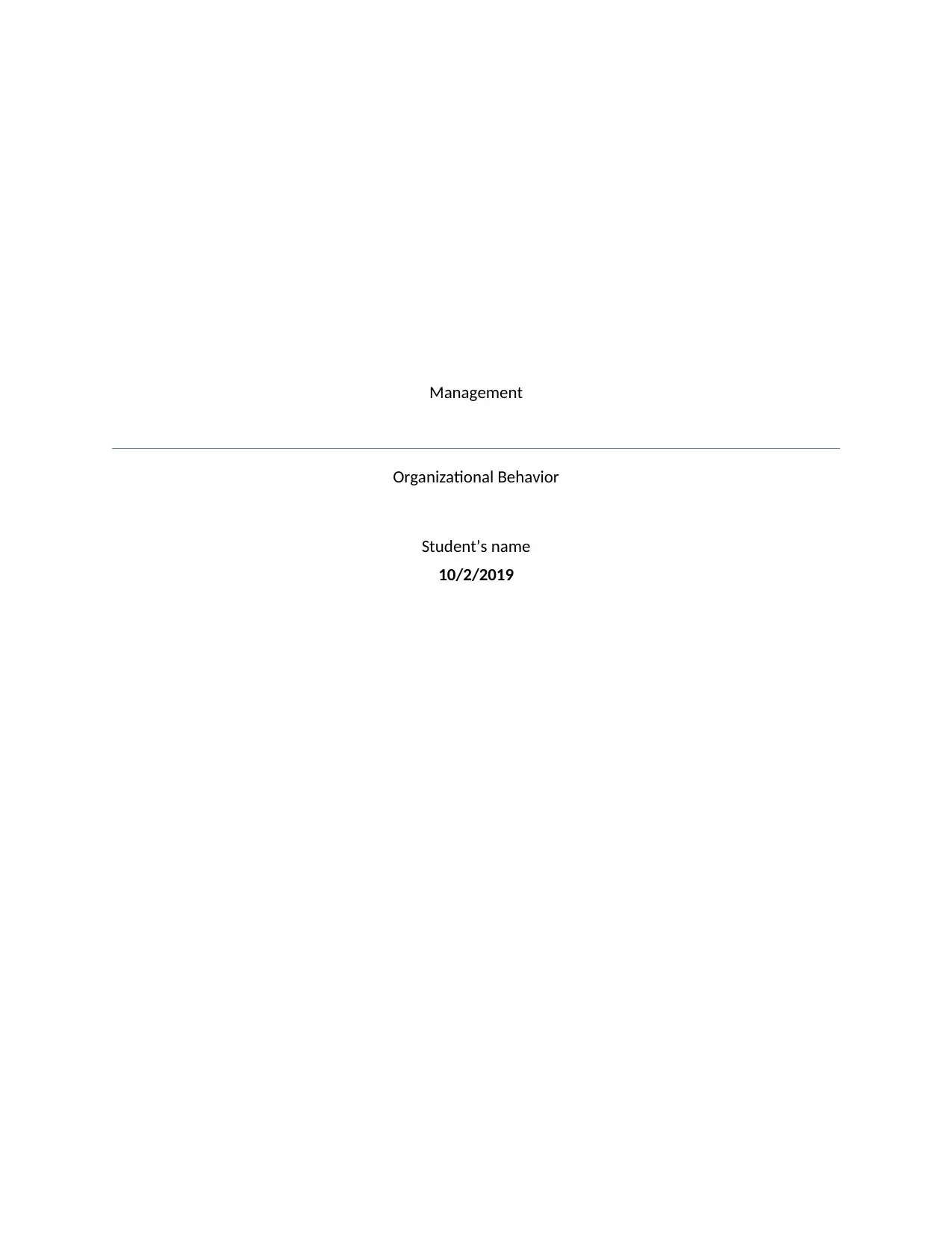
Management
Organizational Behavior
Student’s name
10/2/2019
Organizational Behavior
Student’s name
10/2/2019
Paraphrase This Document
Need a fresh take? Get an instant paraphrase of this document with our AI Paraphraser
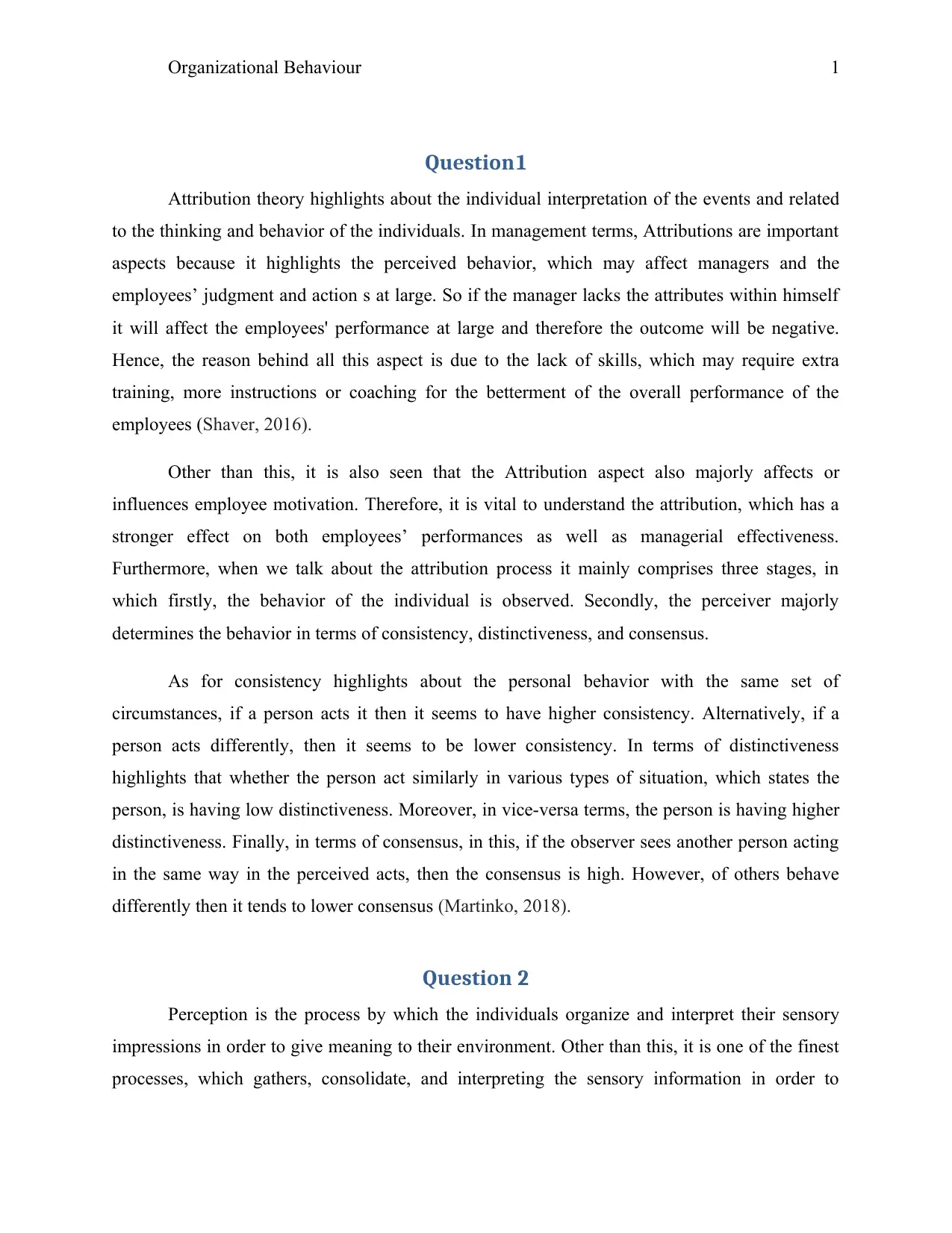
Organizational Behaviour 1
Question1
Attribution theory highlights about the individual interpretation of the events and related
to the thinking and behavior of the individuals. In management terms, Attributions are important
aspects because it highlights the perceived behavior, which may affect managers and the
employees’ judgment and action s at large. So if the manager lacks the attributes within himself
it will affect the employees' performance at large and therefore the outcome will be negative.
Hence, the reason behind all this aspect is due to the lack of skills, which may require extra
training, more instructions or coaching for the betterment of the overall performance of the
employees (Shaver, 2016).
Other than this, it is also seen that the Attribution aspect also majorly affects or
influences employee motivation. Therefore, it is vital to understand the attribution, which has a
stronger effect on both employees’ performances as well as managerial effectiveness.
Furthermore, when we talk about the attribution process it mainly comprises three stages, in
which firstly, the behavior of the individual is observed. Secondly, the perceiver majorly
determines the behavior in terms of consistency, distinctiveness, and consensus.
As for consistency highlights about the personal behavior with the same set of
circumstances, if a person acts it then it seems to have higher consistency. Alternatively, if a
person acts differently, then it seems to be lower consistency. In terms of distinctiveness
highlights that whether the person act similarly in various types of situation, which states the
person, is having low distinctiveness. Moreover, in vice-versa terms, the person is having higher
distinctiveness. Finally, in terms of consensus, in this, if the observer sees another person acting
in the same way in the perceived acts, then the consensus is high. However, of others behave
differently then it tends to lower consensus (Martinko, 2018).
Question 2
Perception is the process by which the individuals organize and interpret their sensory
impressions in order to give meaning to their environment. Other than this, it is one of the finest
processes, which gathers, consolidate, and interpreting the sensory information in order to
Question1
Attribution theory highlights about the individual interpretation of the events and related
to the thinking and behavior of the individuals. In management terms, Attributions are important
aspects because it highlights the perceived behavior, which may affect managers and the
employees’ judgment and action s at large. So if the manager lacks the attributes within himself
it will affect the employees' performance at large and therefore the outcome will be negative.
Hence, the reason behind all this aspect is due to the lack of skills, which may require extra
training, more instructions or coaching for the betterment of the overall performance of the
employees (Shaver, 2016).
Other than this, it is also seen that the Attribution aspect also majorly affects or
influences employee motivation. Therefore, it is vital to understand the attribution, which has a
stronger effect on both employees’ performances as well as managerial effectiveness.
Furthermore, when we talk about the attribution process it mainly comprises three stages, in
which firstly, the behavior of the individual is observed. Secondly, the perceiver majorly
determines the behavior in terms of consistency, distinctiveness, and consensus.
As for consistency highlights about the personal behavior with the same set of
circumstances, if a person acts it then it seems to have higher consistency. Alternatively, if a
person acts differently, then it seems to be lower consistency. In terms of distinctiveness
highlights that whether the person act similarly in various types of situation, which states the
person, is having low distinctiveness. Moreover, in vice-versa terms, the person is having higher
distinctiveness. Finally, in terms of consensus, in this, if the observer sees another person acting
in the same way in the perceived acts, then the consensus is high. However, of others behave
differently then it tends to lower consensus (Martinko, 2018).
Question 2
Perception is the process by which the individuals organize and interpret their sensory
impressions in order to give meaning to their environment. Other than this, it is one of the finest
processes, which gathers, consolidate, and interpreting the sensory information in order to
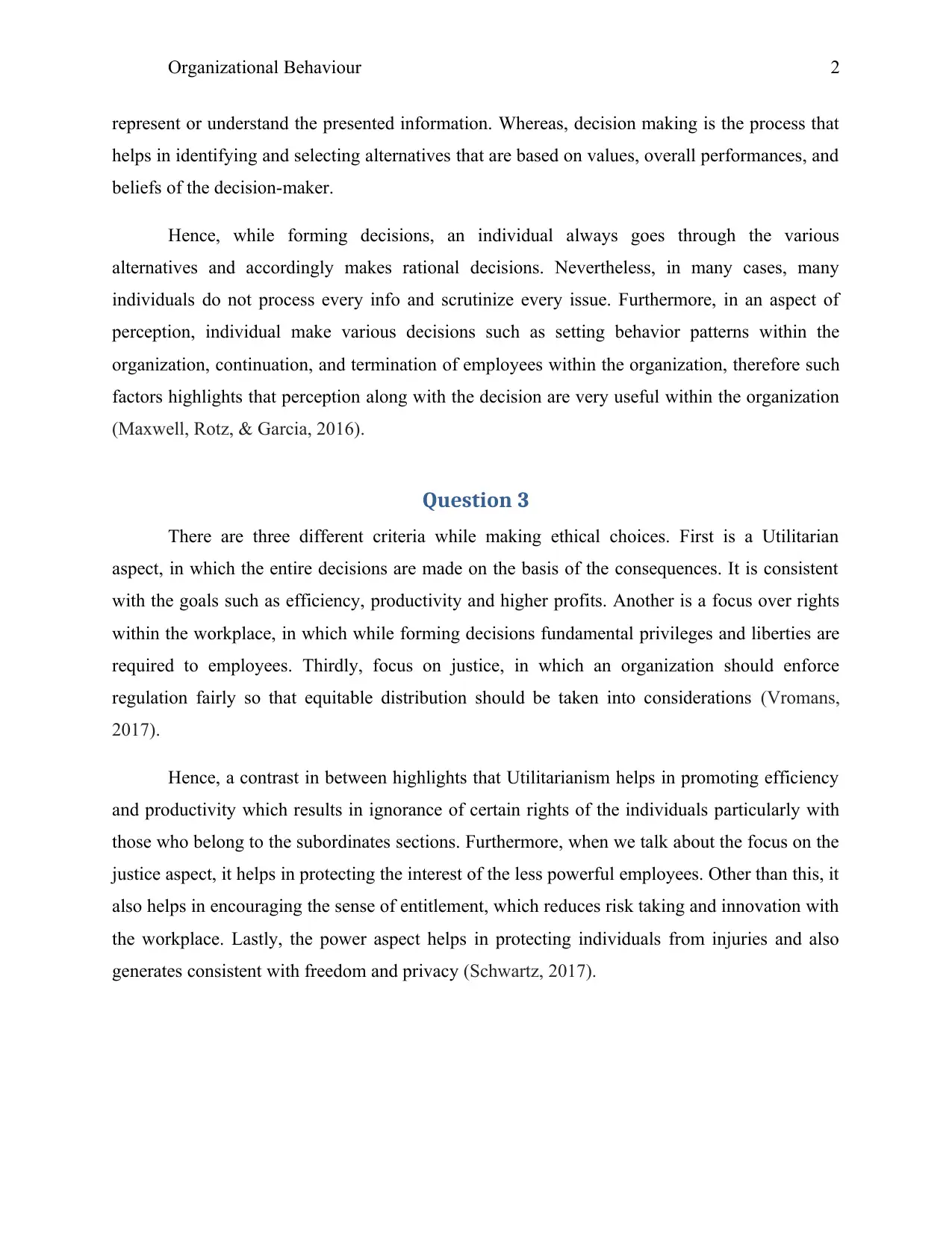
Organizational Behaviour 2
represent or understand the presented information. Whereas, decision making is the process that
helps in identifying and selecting alternatives that are based on values, overall performances, and
beliefs of the decision-maker.
Hence, while forming decisions, an individual always goes through the various
alternatives and accordingly makes rational decisions. Nevertheless, in many cases, many
individuals do not process every info and scrutinize every issue. Furthermore, in an aspect of
perception, individual make various decisions such as setting behavior patterns within the
organization, continuation, and termination of employees within the organization, therefore such
factors highlights that perception along with the decision are very useful within the organization
(Maxwell, Rotz, & Garcia, 2016).
Question 3
There are three different criteria while making ethical choices. First is a Utilitarian
aspect, in which the entire decisions are made on the basis of the consequences. It is consistent
with the goals such as efficiency, productivity and higher profits. Another is a focus over rights
within the workplace, in which while forming decisions fundamental privileges and liberties are
required to employees. Thirdly, focus on justice, in which an organization should enforce
regulation fairly so that equitable distribution should be taken into considerations (Vromans,
2017).
Hence, a contrast in between highlights that Utilitarianism helps in promoting efficiency
and productivity which results in ignorance of certain rights of the individuals particularly with
those who belong to the subordinates sections. Furthermore, when we talk about the focus on the
justice aspect, it helps in protecting the interest of the less powerful employees. Other than this, it
also helps in encouraging the sense of entitlement, which reduces risk taking and innovation with
the workplace. Lastly, the power aspect helps in protecting individuals from injuries and also
generates consistent with freedom and privacy (Schwartz, 2017).
represent or understand the presented information. Whereas, decision making is the process that
helps in identifying and selecting alternatives that are based on values, overall performances, and
beliefs of the decision-maker.
Hence, while forming decisions, an individual always goes through the various
alternatives and accordingly makes rational decisions. Nevertheless, in many cases, many
individuals do not process every info and scrutinize every issue. Furthermore, in an aspect of
perception, individual make various decisions such as setting behavior patterns within the
organization, continuation, and termination of employees within the organization, therefore such
factors highlights that perception along with the decision are very useful within the organization
(Maxwell, Rotz, & Garcia, 2016).
Question 3
There are three different criteria while making ethical choices. First is a Utilitarian
aspect, in which the entire decisions are made on the basis of the consequences. It is consistent
with the goals such as efficiency, productivity and higher profits. Another is a focus over rights
within the workplace, in which while forming decisions fundamental privileges and liberties are
required to employees. Thirdly, focus on justice, in which an organization should enforce
regulation fairly so that equitable distribution should be taken into considerations (Vromans,
2017).
Hence, a contrast in between highlights that Utilitarianism helps in promoting efficiency
and productivity which results in ignorance of certain rights of the individuals particularly with
those who belong to the subordinates sections. Furthermore, when we talk about the focus on the
justice aspect, it helps in protecting the interest of the less powerful employees. Other than this, it
also helps in encouraging the sense of entitlement, which reduces risk taking and innovation with
the workplace. Lastly, the power aspect helps in protecting individuals from injuries and also
generates consistent with freedom and privacy (Schwartz, 2017).
⊘ This is a preview!⊘
Do you want full access?
Subscribe today to unlock all pages.

Trusted by 1+ million students worldwide
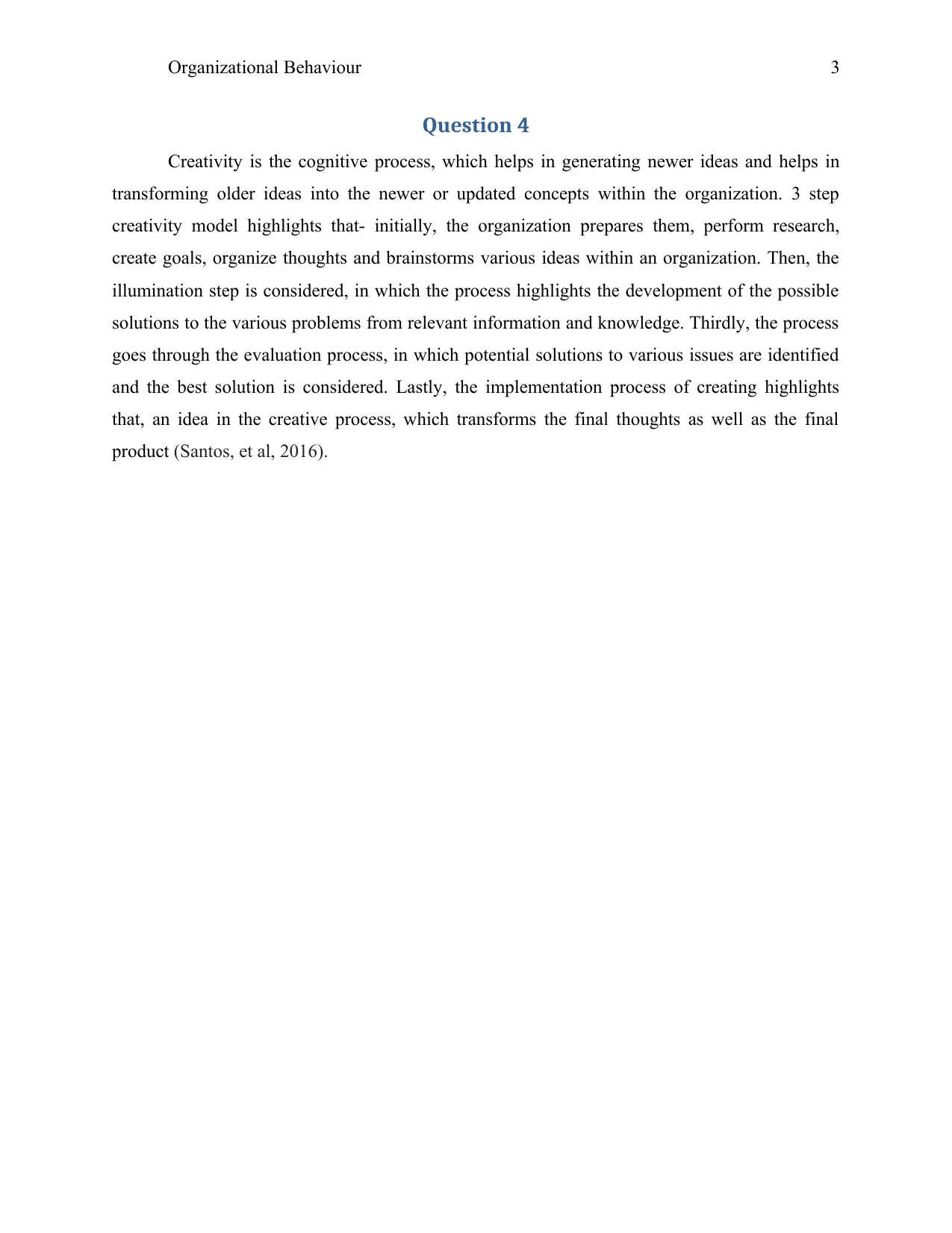
Organizational Behaviour 3
Question 4
Creativity is the cognitive process, which helps in generating newer ideas and helps in
transforming older ideas into the newer or updated concepts within the organization. 3 step
creativity model highlights that- initially, the organization prepares them, perform research,
create goals, organize thoughts and brainstorms various ideas within an organization. Then, the
illumination step is considered, in which the process highlights the development of the possible
solutions to the various problems from relevant information and knowledge. Thirdly, the process
goes through the evaluation process, in which potential solutions to various issues are identified
and the best solution is considered. Lastly, the implementation process of creating highlights
that, an idea in the creative process, which transforms the final thoughts as well as the final
product (Santos, et al, 2016).
Question 4
Creativity is the cognitive process, which helps in generating newer ideas and helps in
transforming older ideas into the newer or updated concepts within the organization. 3 step
creativity model highlights that- initially, the organization prepares them, perform research,
create goals, organize thoughts and brainstorms various ideas within an organization. Then, the
illumination step is considered, in which the process highlights the development of the possible
solutions to the various problems from relevant information and knowledge. Thirdly, the process
goes through the evaluation process, in which potential solutions to various issues are identified
and the best solution is considered. Lastly, the implementation process of creating highlights
that, an idea in the creative process, which transforms the final thoughts as well as the final
product (Santos, et al, 2016).
Paraphrase This Document
Need a fresh take? Get an instant paraphrase of this document with our AI Paraphraser
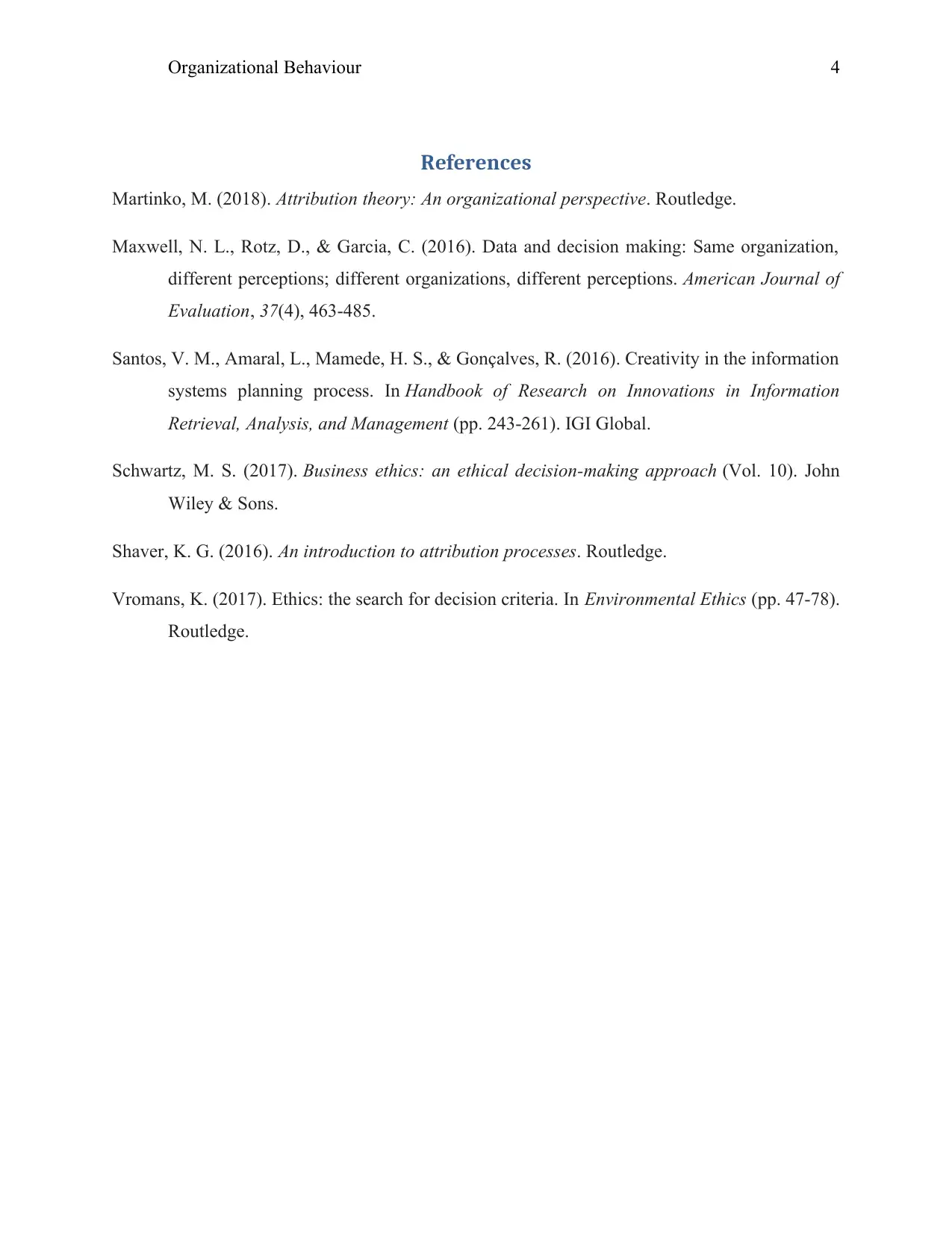
Organizational Behaviour 4
References
Martinko, M. (2018). Attribution theory: An organizational perspective. Routledge.
Maxwell, N. L., Rotz, D., & Garcia, C. (2016). Data and decision making: Same organization,
different perceptions; different organizations, different perceptions. American Journal of
Evaluation, 37(4), 463-485.
Santos, V. M., Amaral, L., Mamede, H. S., & Gonçalves, R. (2016). Creativity in the information
systems planning process. In Handbook of Research on Innovations in Information
Retrieval, Analysis, and Management (pp. 243-261). IGI Global.
Schwartz, M. S. (2017). Business ethics: an ethical decision-making approach (Vol. 10). John
Wiley & Sons.
Shaver, K. G. (2016). An introduction to attribution processes. Routledge.
Vromans, K. (2017). Ethics: the search for decision criteria. In Environmental Ethics (pp. 47-78).
Routledge.
References
Martinko, M. (2018). Attribution theory: An organizational perspective. Routledge.
Maxwell, N. L., Rotz, D., & Garcia, C. (2016). Data and decision making: Same organization,
different perceptions; different organizations, different perceptions. American Journal of
Evaluation, 37(4), 463-485.
Santos, V. M., Amaral, L., Mamede, H. S., & Gonçalves, R. (2016). Creativity in the information
systems planning process. In Handbook of Research on Innovations in Information
Retrieval, Analysis, and Management (pp. 243-261). IGI Global.
Schwartz, M. S. (2017). Business ethics: an ethical decision-making approach (Vol. 10). John
Wiley & Sons.
Shaver, K. G. (2016). An introduction to attribution processes. Routledge.
Vromans, K. (2017). Ethics: the search for decision criteria. In Environmental Ethics (pp. 47-78).
Routledge.
1 out of 5
Related Documents
Your All-in-One AI-Powered Toolkit for Academic Success.
+13062052269
info@desklib.com
Available 24*7 on WhatsApp / Email
![[object Object]](/_next/static/media/star-bottom.7253800d.svg)
Unlock your academic potential
Copyright © 2020–2025 A2Z Services. All Rights Reserved. Developed and managed by ZUCOL.





